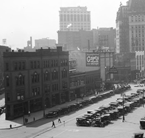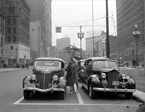
The Automobile Shapes The City
Parking
Even cars at rest—in parking mode if you will—created problems for cities that few other forms of transportation faced. It is ironic that a technology designed to provide individuals with greater flexibility in meeting their transportation needs remains unused much of its life. “An adequate highway system—one affording completely free movement of vehicles—would still not solve our transportation problem,” noted one expert in 1950. “This is because the objective of every motor vehicle is a terminal. The average motor vehicle, for instance, is in motion about 500 hours a year; it is parked the remaining 8,260 hours.” More than forty years later, other experts expressed a similar sentiment: “If one were to set out the most inefficient means of transport, the auto might be the outcome. Consider, for example, the facts that the average auto is parked and unused for about 90 percent of its lifetime and that even when it is used, it is nearly empty.”
The space required to accommodate automobiles when not in use is substantial. A 1981 transit study hypothesized that if an automobile is in use for every two people, then each automobile in a city might need two off-street parking spaces (neither one in a garage) of 250 square feet per space. This would mean that for every 10,000 people, fifty acres would be required for parking alone, which adds 15 to 25 percent to urban land requirements or street space. In addition, cities most dependent on automobiles, that is, cities with high automobile ownership rates as opposed to cities simply with high commuter rates, will require a greater number of parking spaces.
Inner-city traffic also raised problems over parking. In the early part of the twentieth century, parking reduced downtown street area by one third to one half. Furthermore, as the number of cars increased, parking at the curb met only a small percentage of the total parking requirements for the city. Efforts were made, and continue to be made, to ban or limit curb parking and to increase off-street parking to relieve congestion and to house vehicles during the busiest times of the day. As early as 1922, New York and Philadelphia banned parking on their major streets, with other cities following their lead. Also in the 1920s, “No Parking” areas were designated by distinctive painted lines and curbs. More effective was the introduction of the parking meter in Oklahoma City in 1935, with almost 3,000 towns and cities utilizing them by 1950. In recent years, central city parking in the United States has been generally more available than in European and Asian cities, but the problem has not disappeared. It is compounded by the fact that not only motorists, but merchants, property owners, commercial fleets, taxis, and mass transportation all have needs and responsibilities for adequate parking.
In some cases, parking is a kind of “hidden cost” of automobile use paid by government, businesses, and individuals. Cities such as San Francisco, Chicago, and Pittsburgh already were floating bond issues in the 1950s to finance large parking garages. Local building codes and zoning ordinances in most modern cities required developers to provide off-street spaces for every housing or office unit they built. These costs are inevitably passed along to the consumer. This represents a change of heart for cities such as New York, which in 1954 rejected a measure to require most new office buildings to provide off-street parking for 100 to 300 cars on the ground that it would not only increase building costs, but also attract many more cars to the city. However, this response raises the quandary—still being debated—of whether to use incentives or disincentives to deal with downtown automobile congestion. In wealthier Asian cities, for example, there are only 80 car spaces per 1,000 jobs, as opposed to 468 spaces per 1,000 jobs in the United States. These Asian cities have made it clear that they intend to discourage motor traffic as best they can.
<<Previous Section - Next Section>>
Introduction
The “Footprint” of the Automobile on the American City
From “Walking Cities” to “Automobile Cities"
Parking
Filling Stations and Other Services
Expressways, Freeways, and Superhighways
Complete Text Printable View
About the Project | Credits | Contact Us | Student & Teacher Resources | Site Map
©2004-2010 Automobile in American Life and Society

